Latest
Searching for Synergy: How To Win at SEO and PPC in 2021 (and Beyond)
Our Marketing Director Martin Corcoran lead our Search Synergy webinar where we discussed SEO & PPC synergy with our experts to find out how to use these channels together to get the most out of them.
Joined by Summit’s own Carl MacDonald, Content Marketing Strategist, we looked at the state of play in the search landscape and how this is constantly evolving. Our first guest speaker Laurence O’Toole, CEO of Authoritas, discussed further data around the SERPs landscape, taking a deep dive into how the type of keywords used to search, and therefore customer intent, are important. Depending on what keywords are used and whether they’re navigational, informational, research or transactional, massively impacts the SERPs and what features appear. So across SEO and PPC you need to make sure your brand is appearing in the relevant format for these terms.
Summit’s Client Director, Rachel Williams, then focused on how you can drive strategic and tactical efficiencies when you have an aligned PPC and SEO approach, providing key examples from Summit and how this has benefitted our clients.
Martin then finished the session in a fireside chat with Evie Brockwell, Senior Product Manager at Booking.com. As a major travel brand, they have had to change their strategy over the last year thanks to Covid and she gave us plenty of insights into the trends they’ve seen and the tactics they’ve implemented to combat the changing travel demand.
If you missed the webinar, you can rewatch it below and you can sign up to the next one here:
Laurence O’Toole is CEO of Authoritas and is an entrepreneur with 20+ years’ experience in consumer and B2B internet product development, sales and marketing. His experience includes spells in corporate life with Fujitsu & Thomson Directories and in the last couple of years his own boot-strapped ventures. Along the way, he’s built a successful online directory and PPC platform for SMEs, successfully partnering with Google, Microsoft and Yahoo. He’s developed downloadable golf lessons with famous golf coaches and built an advertising funded golf community (not his best idea!). His current venture Authoritas is a big data science-driven SaaS platform for Content Marketing and SEO Professionals worldwide.
Evie Brockwell is Senior Product Manager at Booking.com, where she has worked for the last 4 years. Evie leads the Book Path product group and specialises in optimising for CRO and SEO. She has spent the last few years understanding how to create an ideal customer journey, from the initial research phase to finding and booking the perfect trip. Evie has plenty of words of wisdom on how to optimise your website to have a positive impact on marketing performance.
Searching for Synergy: How to win at SEO & PPC in 2021 (and beyond)
The state of play in the search landscape
As part of our recent voice of the customer research, we found that despite growing social media usage and platforms such as Amazon, Google still offers the greatest reach amongst digital platforms.
If this data tells us one thing, it is that search marketing is still vital to any digital marketing strategy.
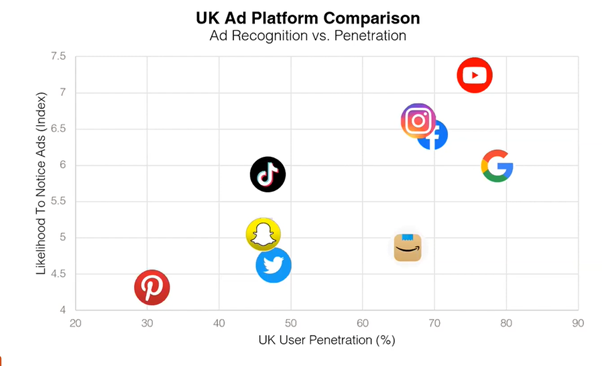
How has the SERP landscape changed over time?
Google is very different to how it once was, in both appearance and under the hood. It is constantly testing new elements and evolving to provide the user with the most relevant information to match their search queries.
In 2004, the Google SERP page wasn’t heavily trusted by its users. PPC ads were highlighted with a pink background, with organic results beneath and users were very hesitant to click on these paid ads, as they were “not to be trusted”.
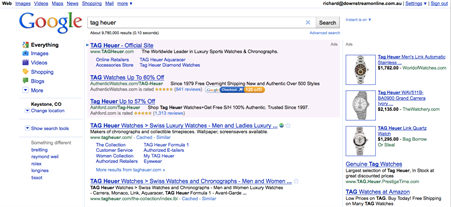
This is no longer the case. As the 2014 Google SERP shows below, the pink background is no more, replaced by a small green piece of text stating “Ad”. There are new Google features visible, plus social media profile links and a knowledge panel available to the right of the page, meaning users no longer need to click on a link to find certain information.
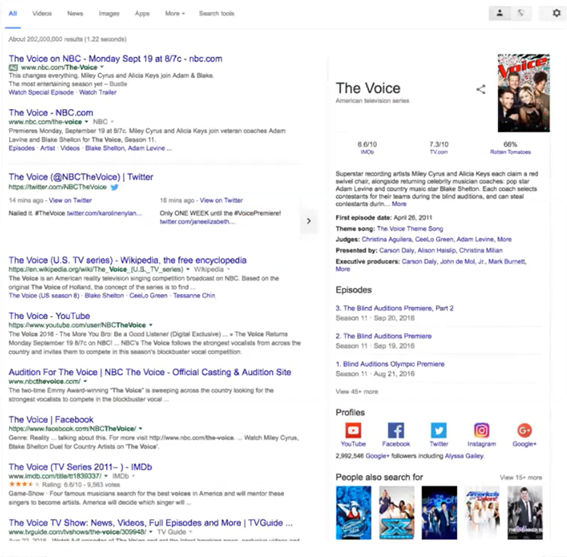
There is a myriad of different features now available on Google, from weather forecasts to dictionary definitions. These are the current 40:
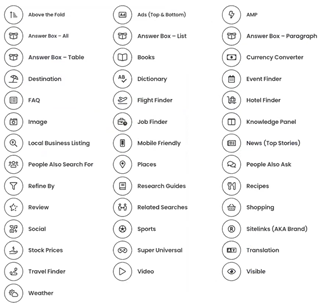
The evolving SERP is changing the way people interact with search results as well.
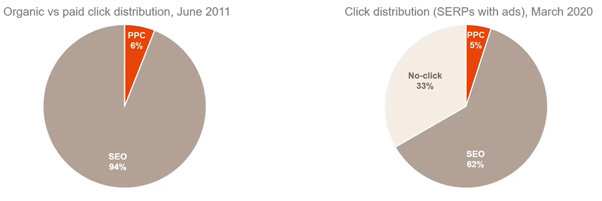
Around a third of searches now end with the user not actually clicking on anything, something which wasn’t apparent a decade ago.
Authoritas – Insights
About Authoritas:
- Building comprehensive SEO software and APIs since 2009.
- Unique SERPs API that emulates a real user and analyses Page 1 of Google in unparalleled depth.
- Collecting billions of search data points every month.
- Helping you grow organic traffic that converts.
Gone are the days where focusing on ranking in the 10 blue links was enough. You have to look at the SERP landscape and pay attention to the Universal SERP Feature Penetration in your country.
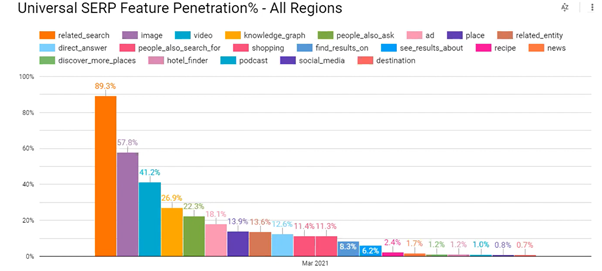
Approximately 90% of all search queries contain a “related search” element, which are at the bottom of the SERP. 57.8% of keywords generate images, 41.2% generate video, 26.9% knowledge graphs. These figures give you a sense of where Google is going, a sense of their headroom for growth (e.g. video is 41.2% in all regions, but around 50% in the U.S.). This is useful, but is it enough? No.
You need to understand what this looks like in your market.
For example, here we have a graphic about consumer electronics. You can see that over 90% of keywords have “people also ask”, so this is something you should consider implementing into your SEO strategy if you’re in that sector. Another good example is “place” at around 28%, showing that 28% of keywords were showing local results. This is a good opportunity for bricks and mortar retailers to ensure they are getting their local SEO right.

Understanding this is really useful as well, but is it enough? No. You need to go a step further.
You need a keyword ranking tool that uses a real browser, such as the tool with Authoritas, where you can emulate the SERPs layout that a real user sees. Rather than just focusing on where you are ranking organically, you can also see where you are ranking across the other universal SERP results and ad features that are appearing in your marketplace.
On the graphic below, we look at keyword rankings and whether they’re above or below the fold and it becomes clear that even if you rank in organic position one, you are likely to appear below the fold because of all the additional features in the landscape; even 87.61% of Amazon’s number one organic results appear below the fold.
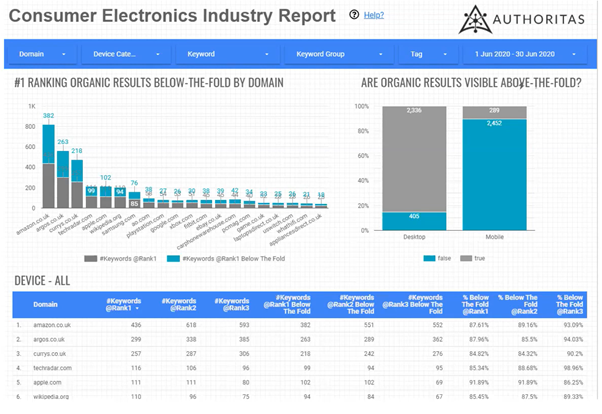
Using the example of travel, the penetration of SERP results is different; you are going to get features such as Google’s hotel finder, travel finder, destination guides, route finder etc. appearing in the SERP, and if you’re not bidding on generic terms, you may find that your number one rank is right down near the bottom of the page, and therefore your CTR will also have dropped.
This perspective is important. Don’t just look at organic ranks, or universal SERP features, but observe universal rankings along with your share of these universal rankings.
So after looking at all the above, now you understand what your share is, what your opportunities are, and the real state around you in regards to bidding and advertising.
But is it enough? No.
You really need to go a step further and understand user intent. You need to break your keywords down into these four areas:
- Navigational – Someone who is looking for a specific company, brand, product, place, entity, social media handle.
- Informational – A lot more fact based. E.g., When was the battle of waterloo?
- Research – Something with commercial intent, where the consumer is window shopping.
- Transactional – The consumer is being more specific, and they are looking to buy in their query.
Having this data at keyword level can help inform your SEO and PPC strategy. When looking deeper into this, merging the SERP feature analysis and user intent analysis, Authoritas asked two questions:
- Does Google return a greater number of a particular SERP feature for a certain user intent?
- For the keywords that trigger a certain SERP feature, what is their average user intent?
Does google return a SERP feature based on user search intent?
It was found that Google typically returns 7 or 8 related searches for every keyword, irrespective of what the user’s intent might be.
Google shows on average more adverts per query for keywords with transactional intent, than keywords with research (1.4x), navigational (9.8x) and informational (70x) intent.
93.7% of ad results are triggered by keywords with a dominant transactional or research intent.
96.8% of shopping results are triggered by keywords with transactional or research intent.
96.6% of the time, research guides are displayed when the keyword has research or transactional intent.
23.9% of featured snippets are triggered by navigational, research or transactional keywords.
Average user intent for keywords that trigger a SERP feature:
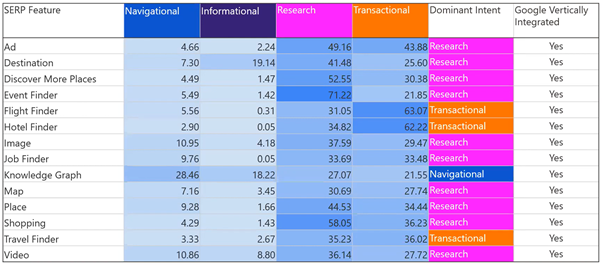
The table above shows what intent each SERP feature held, and whether or not Google went beyond the 10 blue links and integrated their own SERP feature. For example, previously, if you were to search for “nursing Jobs”, you would be presented with sites such as Indeed. Now, Google have created their own “Job Finder”, so searching the term “Nursing Jobs” would present their own feature, and therefore wouldn’t be driving traffic to the likes of Indeed.
The good news is, there are still some ranking opportunities within SERP features with high research or transactional intent, where Google haven’t completely vertically integrated, and therefore is still sending traffic to your site.
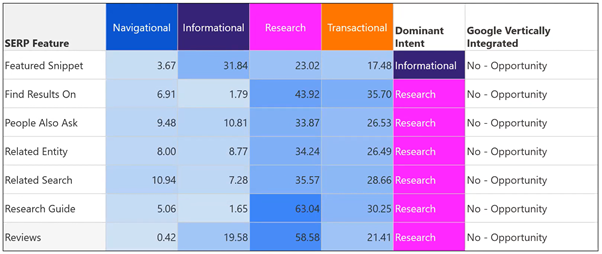
So we’ve looked at organic rankings, universal SERP feature analysis and universal rankings, whether it’s above the fold and understanding user intent. But this still is not enough, unless you are using this data in harmony with your PPC team.
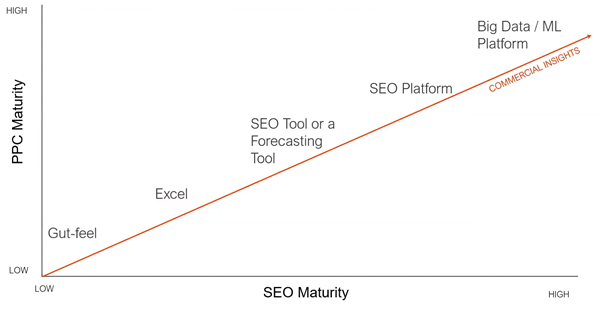
Here is a non-scientific view of SEO and PPC maturity. These axis could be impact, spend, team size, ambition etc. but the more capabilities you have on either axis, the greater opportunity you have for search synergy and joining your data together.
At the lowest level you have “Gut-Feel”, where you are likely just starting out and marketing a couple of products through PPC ads.
The next stage “Excel”, you may start to run a few more PPC campaigns and export some data, joining it up in Excel with ranking information to develop some bidding strategies and keyword decisions.
After this you might move to integrate your data into an SEO or forecasting tool to create more accurate forecast.
This can also be done at a greater scale within an SEO platform.
Eventually you get to the big data platforms, where you can suck a huge amount of data in from all of your PPC and SEO activity and churn that data to receive better commercial insights.
What does all this mean for SEO and PPC?
SEO:
- Knowing your organic rank is not enough.
- You nee to fully understand the SERP layout and competitive landscape.
- Make sure you are matching content to user intent.
- Are you targeting the right Universal SERP features?
- Are your top organic results above-or-below the fold on desktop/mobile?
PPC:
- Understand if you should bid on brand terms.
- Are you building an understanding of under intent into your landing page creation and bidding strategies?
- Are you using PPC data and learnings to inform your SEO strategy and vice versa?
- Are you using A/B testing to improve PPC and inform SEO strategy?
You need to work in harmony between team to generate great results.
How can you drive efficiencies across PPC and SEO strategies?
“PPC and SEO are always in competition with each other”
“Customers avoid PPC ads”
“They are two separate channels and need different strategies”
There have previously been lots of myths about SEO and PPC and we plan to debunk them today.
We have grouped the benefits of SEO and PPC synergy into 3 different areas:
- Sharing hygiene data:
- SEO crawl data used to identify broken PPC links.
- Paid search query reports help identify new content angles / SEO opportunities.
- Testing messaging & optimizing pages:
- PPC creative and messaging testing to inform SEO meta content optimisation.
- Using SEO principles to optimise landing pages and improve PPC quality score.
- Balancing resources and budgets
- Focusing on SEO when PPC is unable to bid on certain keywords.
- Targeting poor ROI or expensive keywords through organic strategies.
- Tactical PPC bidding to mitigate organic keyword fluctuations or algorithm update impact.
Case studies and Summit synergy examples
For one of our fashion clients, we tested paid search messaging to find what the best performing ad-text was. We then applied this information to the organic meta content for the homepage. From this, our CTR increased 19%, and there was a 16% growth in organic sessions YoY. Over the course of the year, this was worth +£936k to the client.
For Ernest Jones, we saw an increase of 20% in organic traffic and an 8% PPC quality score improvement, following the optimisation of PPC landing pages using SEO principals. This saved 36% of budget for the same level of PPC traffic.
Finally, cross channel testing drove a £100k PPC cost saving for one of our clients. When PPC terms are expensive or have a poor ROI, we would look to start driving traffic to those terms through SEO. For this specific client, we saved £100k on PPC cost by not bidding on brand 100% of the time, with a 222% increase in organic CTR.
The Fireside chat with Evie Brockwell from Booking.com
Can you please give us a bit of a take with how booking.com is coping with lockdown and coming out of lockdown, and maybe some changes in behaviour and in the search channel?
In terms of how booking.com is doing, obviously we know that travel has been a very difficult industry to be in over the past year or so, and we started to see those changes around February last year. At first, we thought it would only be a blip, but that was clearly not the case.
We had to adapt a lot to stay on top of the changes. We had to focus on what our customers need now, and how do we cater for that. Plus look at how we operate as a business in this new climate. We ran plenty of experiments and gathered a lot of data, however when the market and landscape shifts drastically, you can’t rely on A/B testing like you once would have. You have to start looking into other strategies, and to try and understand what your customers need, which is difficult in a changing landscape.
We started doing a lot of customer sentiment research, but customer opinions changed on a month-by-month basis depending on how confident they felt in their own market, and what the government policies were.
One of the biggest trends we have seen in travel is a shift to domestic travel, as expected. We also looked at Google trends data and used this to influence how we marketed and amended our website EG searches for “accommodation near me” increasing 110% last year. We quickly added features on-site to cater for that, partially ensuring we are displaying the right content on landing pages, and also providing the right features (filters, the right level of map-functionality etc.), so when customers go through the funnel, we make sure they are converting which keeps our ROI in a good place for all the keywords that we are then bidding for.
How have customers responded?
Really well! One of the interesting things we’ve seen is around things like the “pets” filters. People trying to filter for accommodation suitable for a pet increased two-fold, so there’s been a lot which we have been able to optimise to help people find the right trip for them.
Have the organic and paid teams had to work closely within this period of time?
We scaled down in the PPC space to make sure we are still driving the right ROI. As people are still dreaming of holidays, but not able to go on one at the moment, we saw an increase in traffic but a decrease in conversion rate.
We had to make sure PPC was at the right level, but ensure we were still optimised for SEO, so that we were still getting the right level of traffic. For this, we shared insights across the teams, such as when search terms were increasing, we would focus our SEO strategy on those terms. Also for when we couldn’t spend on PPC, ensuring that we were still ranking well for those specific terms.
What does it mean for the future of booking.com? Has the roadmap changed?
We know that domestic travel is huge at the moment, and there are other markets that we have remained strong for. For us, the US has remained particularly strong as they haven’t experienced the same lockdown experience as we have, and they also already have a strong focus on domestic travel.
So you start to change your strategy to focus on those types of market. Focus on search terms and keywords, but also on the appearance of the landing page.
What are the main challenges that you have found when pivoting the strategy?
A lot of it was being able to adapt quickly internally, and pivoting teams to focus on the right areas. This really helped us to be able to say, “these are the key areas for strategic focus, how do we get marketing and the website development team, all aligned with these new pillars, and how do we quickly get those customer insights to understand what it is that customers do have intent for, what they are looking for and how can we best provide them with the confidence to go through and make the bookings in the right areas”.
How do booking.com manage and share data and planning between teams?
We do have separate teams of PPC specialists and SEO specialists. But there are so many synergies you can get within that space. We catch-up on a regular basis to ensure we are constantly optimising our landing pages, improving quality score, ROI, conversion rate etc.
Whenever we look at new priorities, we look at all the channels and the holistic benefits for each channel. We share a lot of insights for new feature development, and we also have marketing coordinators to make sure we are focusing on the right channels for the right marketing campaigns.
Could you please give us a bit of an insight in terms of the reporting, data and analytics that booking.com use to make the channels more effective?
We have a lot of our own internal reporting, and despite relying on Google for some of their reports, we do a lot of our own research too, such as keyword research. For large projects, we may look to other agencies for their support as well.
We use our own A/B testing tools specifically for SEO, which allow us to run experiments for changing features.
Do you have any thoughts on insights on how booking.com are working with Google’s integrated features?
In our eyes, Google are a partner. In the online landscape, there will always be a slight nervousness around how much Google will take over from other businesses, but we’ve noticed that it’s mostly common, generic terms that Google usually displays features for. There is still a lot of content where they don’t display these features, so for us we aren’t particularly nervous.
On top of this, we have a lot of consumers who come to us directly.
From a customer sentiment point of view, I believe it is quite intimidating when you search for a term and you are instantly presented with “book your hotel right now”, without doing any research. In the travel industry, people typically visit multiple websites before they come to a decision, so I don’t really know how much it will take away from customer sales immediately, or if customers still wish to do that research on their own first.
If you would like to hear more insights from Summit and our guest speakers, sign up to the next webinar here.
Ready for change? Let's talk
Speak to Summit